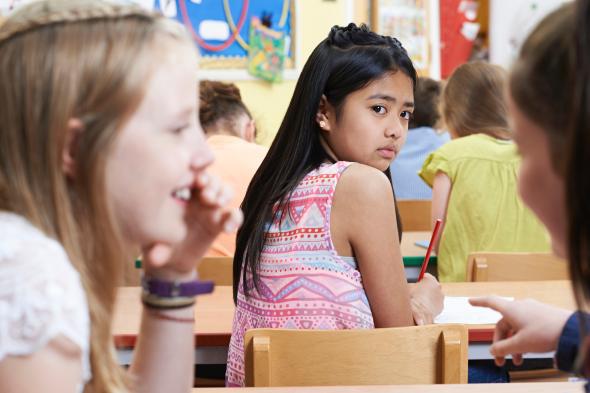The Daily Show mocked Donald Trump this week for having the mind of a toddler. Anderson Cooper has compared him to a 5-year-old to his face. Politico’s Jack Shafer, who has called Trump a 2-year-old, analyzed his language last year and concluded that he talks like a third- or fourth-grader; a column in the Washington Post this year observed that he “speaks like a sixth-grader.” Rolling Stone said he’s “the perfect candidate for a seventh-grade kid.”
It should be no surprise, then, that Trump’s election is having an influence on his emotional and intellectual peers. A large new survey of K-12 educators across the country finds that the election results are making a “profoundly negative impact on schools and students.”
The Southern Poverty Law Center conducted the survey in the days after the election, and 90 percent of the educators who responded have seen their students’ mood and behavior negatively affected by the election of Trump. Eight in 10 reported heightened anxiety among black students, immigrants, Muslims, and LGBTQ students. And those anxieties are perfectly reasonable: Four in 10 educators have heard derogatory language directed at marginalized students, and about 25 percent described specific episodes of bigotry connected to the election. The online survey was informal and didn’t draw on a nationally representative sample, but more than 10,000 teachers, counselors, administrators, and other school employees responded.
The specific accounts compiled the SPLC report are almost as disturbing as the portrait in aggregate. Here are just a few excerpts of the kinds of vandalism, threats, fights, and harassment teachers have witnessed since Nov. 8:
“Today I photographed vandalism in the boy’s bathroom that mentioned a specific black student (1 of 7 in a school of 200). It repeatedly mentioned the KKK, used the n-word and joining Jews. A student drew a swastika on my board a few days ago. A black female ran out of a room crying after being racially harassed by multiple students during two different classes.” — high school teacher, Oregon
“The day after the election, white students in my school walked down the halls harassing their students of color. One student went around asking, ‘Are you legal?’ to each student he passed. Another student told his black classmate to ‘Go back to Haiti because this is our country now.’” — middle school student teacher, Massachusetts
“Seventh-grade white boys yelling, ‘Heil Trump!’” — high school teacher, Colorado
“Words that I have not heard in the past—racist, bigot, pussy, slut—are now used by my fourth-graders.” — elementary school teacher, Minnesota
Teachers saw these issues percolating months before the election. In October, the country’s largest teachers union released an ad linking Trump’s rhetoric to incidents of school bullying. In April, back when Trump’s looming media presence seemed destined to expire in November, the SPLC published the results of another survey on the “Trump effect” in schools. Even then, educators reported his campaign was producing “alarming levels of fear and anxiety among children of color and inflaming racial and ethnic tensions in the classroom.” (Both SPLC surveys were conducted as part of the organization’s Teaching Tolerance project, which provides resources on justice and diversity. It’s worth noting that although the surveys were open to any educator, they seem to have drawn heavily from those already attuned to these goals.)
If schools are microcosms of society, then both are looking like increasingly frightening places these days. Within just a few days of Trump’s victory, observers were reporting a major spike in incidents of vandalism and threats against the many groups of people he had denigrated on the campaign trail. Spray-painted swastikas have appeared on driveways, cars, and school walls; women in hijabs have been screamed at and attacked; churches with rainbow banners have been spray-painted with slurs like “fag church”; ethnic minorities of all kinds have been told to “go back” to Mexico or Africa. Within 10 days of the election, the SPLC counted 867 hate incidents in the United States, not including online episodes; many of the perpetrators have explicitly invoked the president-elect’s name. By now it is clear that Trump’s victory has emboldened a subset of angry, violent white people across the country. Their children, it seems, have been listening, too.
